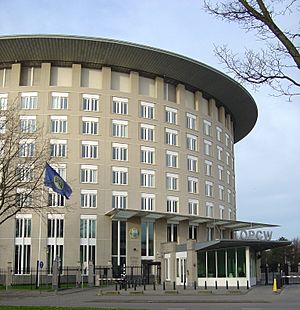Chemical Weapons Convention facts for kids
| Convention on the Prohibition of the Development, Production, Stockpiling and Use of Chemical Weapons and on their Destruction | |||
|---|---|---|---|

Countries that are part of the Chemical Weapons Convention
|
|||
| Drafted | 3 September 1992 | ||
| Signed | 13 January 1993 | ||
| Location | Paris and New York | ||
| Effective | 29 April 1997 | ||
| Condition | Ratification by 65 states | ||
| Signatories | 165 | ||
| Parties | 193 (List of state parties) Four UN states are not party: Egypt, Israel, North Korea and South Sudan. |
||
| Depositary | UN Secretary-General | ||
| Languages | Arabic, Chinese, English, French, Russian and Spanish | ||
The Chemical Weapons Convention (CWC) is an important arms control agreement. It makes chemical weapons illegal. This means countries are not allowed to make, store, or use these dangerous weapons. Most countries in the world are part of this agreement.
The full name of the CWC is the Convention on the Prohibition of the Development, Production, Stockpiling and Use of Chemical Weapons and on their Destruction.
The Organization for the Prohibition of Chemical Weapons (OPCW) helps manage the CWC. The OPCW makes sure that countries follow the rules. They do this by checking facilities and making sure chemical weapons are destroyed.
As of August 2022, 193 countries have joined the CWC. This means they agree to follow its rules. A few countries, like Israel, have signed the agreement but not fully joined it. Three other countries (Egypt, North Korea, and South Sudan) have not signed or joined at all. In 2013, Syria joined the convention. This was part of a plan to destroy its chemical weapons.
By February 2021, almost all (98.39%) of the world's declared chemical weapons had been destroyed. The CWC also has rules for checking places that make chemicals. This helps make sure these chemicals are not used to create weapons.
Contents
Organisation for the Prohibition of Chemical Weapons (OPCW)

The Organisation for the Prohibition of Chemical Weapons (OPCW) is the group that runs the CWC. It is the main place where decisions about the convention are made.
The Conference of the States Parties is a meeting where countries that are part of the CWC can change the rules. They can also create new rules to help carry out the CWC's goals.
The OPCW has a special team called the Technical Secretariat. This team visits member countries to make sure they are following the rules. They inspect places where chemical weapons are destroyed. They also check factories that used to make chemical weapons or that make chemicals that could be used for weapons.
The OPCW can also investigate if someone says chemical weapons have been used. They can also offer help to countries if chemical weapons have been used against them.
The OPCW won the 2013 Nobel Peace Prize. The Nobel Committee said the OPCW helped make chemical weapons a "taboo" (something completely forbidden) under international law.
Main Goals of the Convention
The Chemical Weapons Convention has several important goals:
- To stop the making and use of chemical weapons.
- To destroy all places that make chemical weapons. If they can't be destroyed, they must be changed to make other things.
- To destroy all chemical weapons, even old ones left in other countries.
- To provide help between countries and the OPCW if chemical weapons are used.
- To have the OPCW inspect places that make chemicals. This is to make sure these chemicals are not turned into weapons.
- To encourage countries to work together to use chemistry for peaceful purposes.
Chemicals Under Control
The CWC groups chemicals into three main types. These are chemicals that can be used as weapons or to make weapons. The groups depend on how much of the chemical is made for normal, non-weapon uses. Each group has two parts: Part A (chemicals that are weapons themselves) and Part B (chemicals used to make weapons).
The CWC also defines "toxic chemicals." These are any chemicals that can cause death or harm to humans or animals. This includes all such chemicals, no matter how they are made or where they are found.
- Schedule 1 chemicals are very dangerous. They have almost no uses outside of chemical weapons. Countries can only make or use very small amounts for research, medicine, or testing defenses against chemical weapons. If a country makes more than 100 grams (about 3.5 ounces) per year, they must tell the OPCW. A country can only have a maximum of 1 tonne (about 2,200 pounds) of these materials. Examples include sulfur mustard and nerve agents. Some of these chemicals have tiny medical uses, like treating certain cancers.
- Schedule 2 chemicals have some normal, small-scale uses. Countries must report if they make these chemicals. There are also rules about selling them to countries that are not part of the CWC. An example is thiodiglycol. This chemical can be used to make mustard agents, but it is also used in inks.
- Schedule 3 chemicals have many large-scale uses that are not related to weapons. Factories that make more than 30 tonnes (about 66,000 pounds) per year must be reported and can be inspected. There are also rules about selling these to countries not in the CWC. Examples include phosgene and triethanolamine. Phosgene was a chemical weapon in World War I, but it is also used to make many useful chemicals, like medicines and pesticides. Triethanolamine is used to make nitrogen mustard, but it is also common in soaps and cleaners.
See also
 In Spanish: Convención sobre Armas Químicas para niños
In Spanish: Convención sobre Armas Químicas para niños

